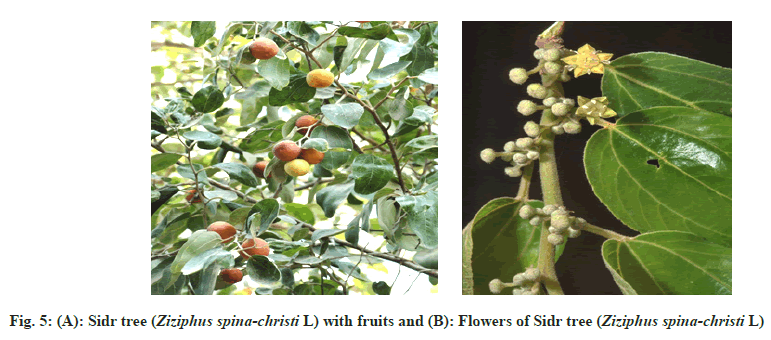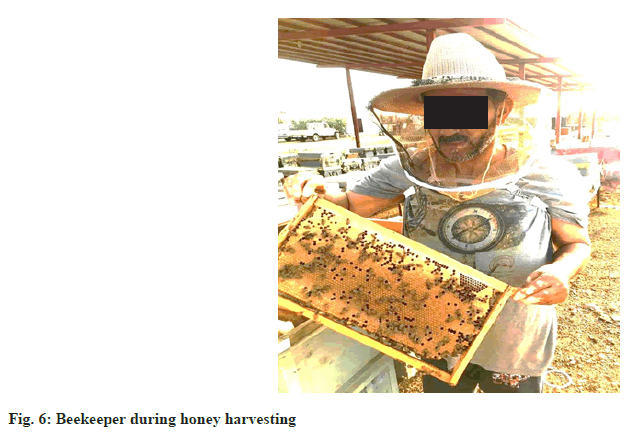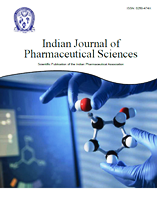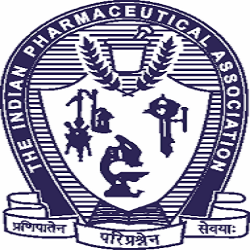- *Corresponding Author:
- Salama A Salama
Department of Zoology, Faculty of Science, Damanhur University, Damanhur, Egypt
E-mail: sasalama@jazanu.edu.sa
| Date of Received | 10 October 2025 |
| Date of Revision | 09 September 2025 |
| Date of Accepted | 06 September 2025 |
| Indian J Pharm Sci 2025;87(5):197-202 |
This is an open access article distributed under the terms of the Creative Commons Attribution-NonCommercial-ShareAlike 3.0 License, which allows others to remix, tweak, and build upon the work non-commercially, as long as the author is credited and the new creations are licensed under the identical terms
Abstract
Honey is a natural product produced by bees. It is a sweet and highly viscous product. Honeybees collect flowers nectar or plant-sucking insects' secretions and secrete their enzymes to make honey. One of the main enzymes in honey is diastase. It can split the starch in the nectar into dextrin and maltose. Diastase is a useful indicator of the freshness and quality of honey. Many factors can affect in its activity. In this study, we measured the diastase enzyme's action in four types of Sidr honey, South Saudi Sidr honey, Anab Sidr honey, Pakistani (Kashmiri) Sidr honey and Yemeni Sidr honey by using ultra violet visible spectroscopy system. The mean values were 32.37 IU/kg, 26.86 IU/kg, 17.28 IU/kg and 16.37 IU/kg respectively. We found that the South Saudi Sidr honey has a high diastase number activity compared to other tested honey.
Keywords
Diastase, Ziziphus spina-christi tree, spectrophotometer, Sidr honey
Honeybees can produce honey from varies natural sources such as floral nectar, trees exudates and honeydew[1]. Since the ancient times, human used a honey as food and medical product[2]. Honey is a highly nutritious product contains carbohydrates, water, minerals, free amino acids, vitamins, and proteins. It has pigments, flavonoids and antibacterial activity[3,4]. Honey is a good source for energy, where it yields 64 calories per tablespoon[5]. Glucose oxidase, invertase, and diastase (amylase) are the common enzymes found in honey[6]. Honeybees collect flowers nectar or the secretions of insects that feed on plants and add these enzymes to produce honey. Honey enzymes are secreted from the salivary and pharyngeal glands of honeybees into their stomach during honey production[7]. Catalase and acid phosphatase are other enzymes found in honey. The plants and microbes are the sources of catalase enzyme while nectar, pollen, and yeast are the sources of acid phosphatase. Diastase is one of the main enzymes found in honey among those[8]. It is secreted by honeybees during collection and ripening of flowers nectar. Diastase can breakdown the starch in nectar to dextrin and maltose[9]. It serves as a practical gauge of honey's freshness[10]. In the past, a number of European nations utilized diastase as a gauge for honey quality. The content of diastase can vary by floral source and geographical region. Many factors can affect its quantification such as exposure to high temperature and long-time storage[2]. The bees inadequate nectar digestion during a plentiful nectar flow[11], or pharyngeal gland seasonal activity can effect on diastase activity[12,13]. In this manuscript, we measured the diastase activity for many types of Sidr honeys, such as South Saudi Sidr Honey (SSSH), Anab Sidr Honey (ASH), Pakistani Sidr Honey (PSH) and Yemeni Sidr Honey (YSH). We showed that SSSH has higher diastase activity than ASH, PSH and YSH. This is may depend on several factors.
Materials and Methods
Honey samples:
Four types of Sidr honey according to the country origin were collected from KSA markets and stored in container at 4° until analysis.
Chemicals and reagents:
Iodine solution (0.0007 N), acetate buffer-pH 5.3, sodium chloride solution (0.5 m), and starch solution 2 %.
Instrumentation:
In this experiment, we used two instruments, spectrophotometer and Water bath. The absorbance of the solutions was determined at 660 nm by using a HACH LANGE DR/3900 spectrophotometer.
Preparation of honey solution:
After weighing a 10.0 g sample of honey, 5.0 ml of acetate buffer solution was added to a 50 ml beaker. The honey sample was then dissolved by adding 20 ml of water. 3.0 ml of sodium chloride solution was added to a 50 ml volumetric flask containing the dissolved material. 50 ml was the new volume. The honey was buffered first.
Diastase activity:
A 10 ml of honey solution was transferred to a 50 ml graduated cylinder and was put in the water bath at 40° along with a flask containing starch solution. After 15 min, 5 ml starch solution was added to the honey solution, mixed and stop-watch was started. At 5 min intervals, 1 ml was removed of aliquots and 10 ml 0.0007 N iodine solution was added and mixed then diluted up to 35 ml. The absorbance was read at 660 nm of aliquots at intervals up to reached absorbance of 0.235.
The Diastase Number (DN) was calculated by dividing 300 by the time in minutes. This number expresses the diastase activity as ml of 1 percent starch solution was hydrolyzed by the diastase enzyme in 1 g of honey during 1 h at 40°. This diastase number corresponds with the Gothe-scale number. Diastase activity=DN=ml starch solution (1 %)/g honey/h at 40°[14].
Statistical analysis:
Every experiment was carried out three times. At the 95 % (p<0.05) confidence level, the mean differences were deemed statistically significant.
Results and Discussion
The diastase enzyme is one types of enzymes found in honey and contributes to its nutritional value. It is produced by bees during honey ripening. The evaluation of diastase enzyme activity is used as indicator for honey quality.
Four types of honey were estimated for DN activity. From Table 1, the SSSH for ten samples had the highest mean value of DN activity with 32.37 IU/kg. The mean Standard Deviation (SD) of ten samples of SSSH equal to 6.25 (Table 1 and fig. 1). The data in Table 2 showed that the mean value of DN activity of estimated ten samples of ASH was 26.86 IU/kg less than the DN of SSSH. Whereas, the mean standard deviation (SD) value of ten samples of ASH showed at 5.18 (Table 2 and fig. 2). The estimation of ten samples from Pakistani (Kashmiri) Sidr honey (PSH) appeared mean value of DN activity with 17.28 IU/kg lower than ASH. While the mean SD of ten samples from PSH was 3.34 (Table 3 and fig. 3). From data presented in Table 4, the estimated ten sample of YSH exhibited DN activity with mean value of 16.37 IU/kg lower than PSH and mean SD for ten samples was at 2.18 (Table 4 and fig. 4).
| Sample | 1 | 2 | 3 | 4 | 5 | 6 | 7 | 8 | 9 | 10 | Mean value of DN | SD |
|---|---|---|---|---|---|---|---|---|---|---|---|---|
| DN (IU/kg) | 31.5 | 33.3 | 32 | 37.5 | 24 | 38.4 | 24 | 37.5 | 32 | 40.5 | 32.37 | 6.25 |
Table 1: The DN Activity of SSSH
| Sample | 1 | 2 | 3 | 4 | 5 | 6 | 7 | 8 | 9 | 10 | Mean value of DN | SD |
|---|---|---|---|---|---|---|---|---|---|---|---|---|
| DN (IU/kg) | 33.3 | 30 | 22.2 | 31.5 | 30.6 | 26.3 | 17.2 | 30 | 21.4 | 26.1 | 26.86 | 5.18 |
Table 2: The DN Activity of SSSH
| Sample | 1 | 2 | 3 | 4 | 5 | 6 | 7 | 8 | 9 | 10 | Mean value of DN | SD |
|---|---|---|---|---|---|---|---|---|---|---|---|---|
| DN(IU/kg) | 12.8 | 20.9 | 17.6 | 15.3 | 13.9 | 15 | 23.1 | 18.7 | 20 | 15.5 | 17.28 | 3.34 |
Table 3: The DN Activity of SSSH
| Sample | 1 | 2 | 3 | 4 | 5 | 6 | 7 | 8 | 9 | 10 | Mean value of DN | SD |
|---|---|---|---|---|---|---|---|---|---|---|---|---|
| DN (IU/kg) | 15.9 | 15.2 | 17.2 | 15.9 | 18.7 | 16.8 | 13.1 | 13.3 | 20 | 17.6 | 16.37 | 2.18 |
Table 4: The DN Activity of SSSH
The results showed that SSSH had highest value of DN activity with (32.37 IU/kg) followed by ASH with (26.86 IU/kg), Pakistani (Kashmiri) Sidr honey (PSH) with (17.28 IU/kg) and YSH with (16.37 IU/kg). The highest diastase enzyme activity was found in the SSSH with 32.37 IU/kg, while the lowest was found in YSH.
Sidr honey is one of honey types. It is a natural product produced by bees. Sidr honey is popular because of its exquisite taste and health benefits. Sidr honey is made by bees which feed only on the nectar of Sidr tree (Ziziphus spina-christi L.) (fig. 5). It is rich with many antioxidants and several bioactive compounds like vitamins, phenolic, flavonoids, and fatty acids along with these properties; it has also anticancer activities and antimicrobial activity against many types of pathogenic bacteria such as Bacillus cereus, Staphylococcus aureus, Escherichia coli, Salmonella enteritidis, and fungi like Trichophyton mentagrophytes.
This study aims to evaluate the freshness and quality of four types of Sidr honeys, SSSH, ASH, PSH and YSH. The mean values activity of diastase number was as follows, the highest one is SSSH with 32.27 IU/kg (Table 1 and fig. 1), then ASH with 26.86 IU/kg (Table 2 and fig. 2), while PSH was 17.28 IU/kg (Table 3 and fig. 3) and YSH had nearly half of SSSH value that of 16.37 IU/kg (Table 4 and fig. 4). We investigated that the SSSH had a highest diastase activity than Anab, Pakistani and YSH (Table 5). The diastase enzyme is one types of honey enzymes contributes in its nutrition value. During honey ripening, the bees add diastase enzyme which in turn breakdown the glucosidic bonds in starch and oligo- and polysaccharides then converts it into simple sugars. The diastase enzyme in honey is used to assess its quality[15]. During estimation of honey, if diastase enzyme is absent, this indicates that this honey is a fake. The adulteration honey has undetectable diastase enzyme and it has DN value zero and the content is usually solely sugar. The diastase enzyme amount in honey based on ability of bees to produce saliva. The higher value of diastase enzyme in honey indicates to high concentration of bees saliva. The diastase enzyme activity in honey is an indicator of its quality. The good assessment of diastase activity is shortly after harvesting of honey (fig. 6). The suitable temperature for honey storage is at room temperature nearly 26° and cold (±5°) temperatures. The decreasing in diastase activity can be during long time of storage or after heating[18]. Diastase enzyme is a useful parameter of freshness and quality of honey. This indicates that SSSH was fresher and has more quality than other tested Sidr honey. The activity level of the diastase enzyme can be affected by various factors such as during harvest, water content, long-time storage and exposure to high temperature and honey acidity[2].
| Honey type | Mean value of DS (IU/kg) | SD |
|---|---|---|
| SSSH | 32.37 | 6.25 |
| ASH | 26.86 | 5.18 |
| PSH | 17.28 | 3.34 |
| YSH | 16.37 | 2.18 |
Table 5: The DN Activity and Standard Deviation (SD) of Four Sidr Honeys
The decrease in the diastase activity level of ASH, PSH, and YSH to SSSH may be because time of storage, the pH outside range of 5.3-5.6 or exposure to high temperature. The poor processing of Sidr nectar by bees or seasonal activity of the salivary and pharyngeal glands are other factors may also lead to decrease in the diastase levels[12]. The qualitative parameters of European standards described that a diastase activity index is no less than 8 IU/kg[16]. According to this indicator, the four types of Sidr honey have the same quality. Further studies can be conducted such as determination of Hydroxymethylfurfual (HMF) and water content.
Diastase enzyme in honey is one of a useful parameter for estimating the freshness and quality. In this current study, it concluded that SSSH had highest DN activity indicating that it was fresher other than tested Sidr honey. Furthermore, all tested sidr honeys exhibited same quality as the values of DN activity were above 8 IU/kg (The qualitative parameters of European standards). The freshness and quality of honey appears that it contains a vital antioxidant and flavonoids compounds.
Acknowledgment:
The authors gratefully acknowledge the funding of the Deanship of Graduate Studies and Scientific Research, Jazan University, Saudi Arabia, through Project number: (JU- 202503299 -DGSSR- RP -2025).
Author’s contribution:
All authors contributed equally. All authors read, revised, and approved the final manuscript.
Data availability:
All data supporting the findings of this study are available within the manuscript.
Conflict of interests:
The authors declared no conflict of interests.
References
- Bassey IH. Beekeeping: digest of selected literature on beekeeping, honey and beeswax processing. Libriservice limited: Lagos, Nigeria; 1986. p. 22.
- Chou WM, Liao HC, Yang YC, Peng CC. Evaluation of honey quality with stored time and temperatures. J Food Nutr Res 2020;8:591-9.
- Pérez RA, Sánchez-Brunete C, Calvo RM, Tadeo JL. Analysis of volatiles from Spanish honeys by solid-phase microextraction and gas chromatography-mass spectrometry. J Agric Food Chem 2002;50(9):2633-7.
[Crossref] [Google Scholar] [PubMed]
- Terrab A, González AG, Díez MJ, Heredia FJ. Characterisation of Moroccan unifloral honeys using multivariate analysis. Eur Food Res Technol 2003;218(1):88-95.
- Abeshu MA, Geleta B. Medicinal uses of honey. Biol Med 2016;8(2):1000276.
- Kostić D, Arsić B, Mrmošanin J, Spasić S, Georgijev A. Determination of the invertase activity in honey samples as the indicator of the authenticity of honey by UV/VIS spectrophotometric method. Chem. Naissens 2022;4:93-103.
- Al‐Sherif AA, Mazeed AM, Ewis MA, Nafea EA, Hagag ES, Kamel AA. Activity of salivary glands in secreting honey‐elaborating enzymes in two subspecies of honeybee (Apis mellifera L). Physiol Entomol 2017;42(4):397-403.
- Oddo LP, Baldi E, Accorti M. Diastatic activity in some unifloral honeys. Apidologie 1990;21(1):17-24.
- White JW, Doner LW. Honey composition and properties. Beekeeping in the United States Agriculture Handbook. 1980;335:82-91.
- Oddo LP, Baldi E, Accorti M. Diastatic activity in some unifloral honeys. Apidologie 1990;21(1):17-24.
- Sipos E. The latest problems of honey evaluation. XIX Int. Bee keep. Congress, Prague; 1964. p. 643-6.
- Halberstadt K. Elektrophoretische untersuchungen zur sekretionstätigkeit der hypopharynxdrüse der honigbiene (Apis mellifera L.). Sectes Sociaux 1980;27(1):61-77.
- Fluri P, Lüscher M, Wille H, Gerig L. Changes in weight of the pharyngeal gland and haemolymph titres of juvenile hormone, protein and vitellogenin in worker honey bees. J Insect Physiol 1982;28(1):61-8.
- Saudi Arabian Standards Organization (SASO). Saudi Arabian standards, test methods of honey No. 102. Saudi Arabia: Ministry of Commerce; 1990.
- Codex Alimentarius Commission. Recommended European Regional Standard for Honey; 1969,
- Sukmawati, Noor A, Firdaus. 2015. Analysis of the quality of Mallawa honey based on physicochemical parameters. Ind J Chem Res 2015;3: 259-62.
- Pujiarti R, Amin A, Ngadianto A, Septiana RM, Purba BA, Permadi DB. Quality of Three Forest Honey Types from Baduy Tribe, Lebak District, Banten Province. Jurnal Ilmu Kehutanan 2021;15(2):123-36.
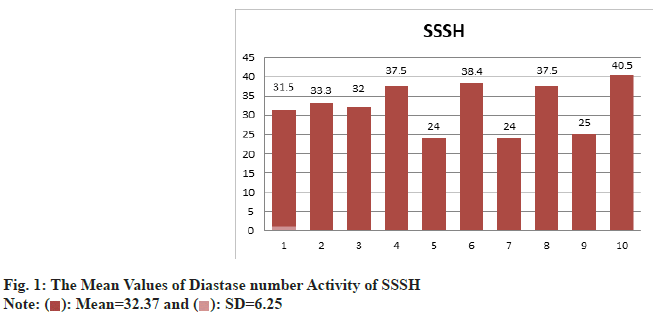
 ): Mean=32.37 and (
): Mean=32.37 and ( ): SD=6.25
): SD=6.25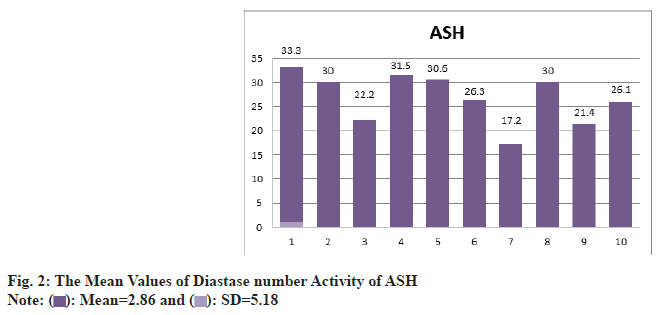
 ): Mean=2.86 and (
): Mean=2.86 and ( ): SD=5.18
): SD=5.18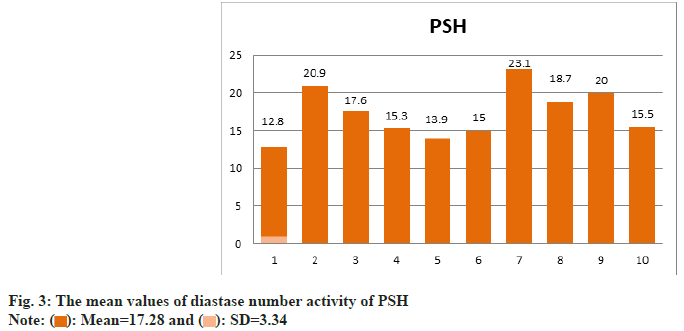
 ): Mean=17.28 and (
): Mean=17.28 and ( ): SD=3.34
): SD=3.34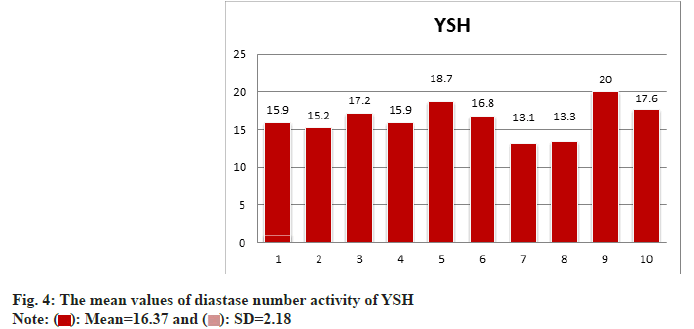
 ): Mean=16.37 and (
): Mean=16.37 and ( ): SD=2.18
): SD=2.18